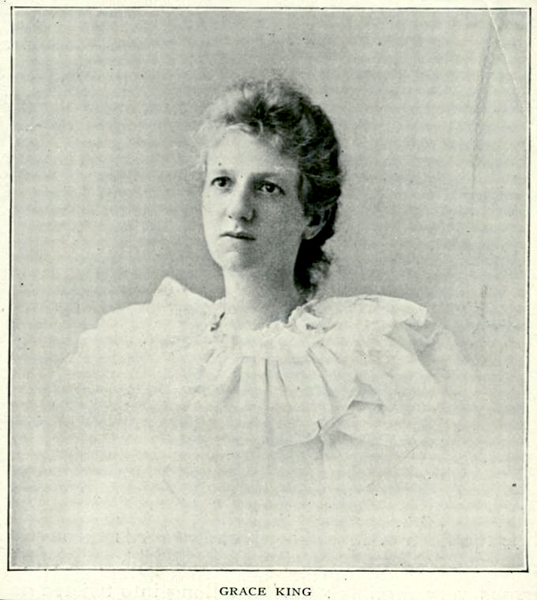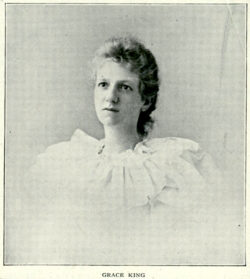Grace King
New Orleans novelist and historian Grace King made the city and state of her birth an abiding theme in her work.

Courtesy of New York Public Library
Grace King. Unidentified
New Orleans novelist and historian Grace King made the city and state of her birth an abiding theme in her work. Prolific in several genres—short fiction, the novel, memoir, biography, social and cultural history—King published her work in major national magazines, such as Harper’s, Century, and The Yale Review. Her fiction, often inspired by her experiences, treated the lives of young girls and older women dispossessed by the Civil War. Her historical studies focused on the settlement of Louisiana, and the development of New Orleans and its notable Creoles, a group she narrowly defined to exclude Creoles of Color. In both genres, King dramatized women’s experiences across the color line, capturing Louisiana’s complex racial identity.
Early Life
Born November 29, 1852, King was the daughter of William Woodson King, a New Orleans attorney and his wife, Sarah Ann Miller. The outbreak of the Civil War and the subsequent occupation of New Orleans by Federal troops interrupted King’s childhood and formal education. During the occupation, the Kings fled to their plantation, where Grace King was tutored by her parents and grandmother. Like many antebellum aristocrats, the Kings lost most of their wealth in the war but maintained their social status. Though neither a Creole nor a Catholic, King attended French-speaking Catholic convent schools when the family returned to New Orleans after the war. She moved freely among these circles and knew their customs and practices intimately. After graduating from the Institut St. Louis, a New Orleans school for girls, she studied at the Sylvester-Larned Institut and the Institut Cenas, also in New Orleans.
Fictional Writings
King’s writing career began with a challenge from the northern editor of Century magazine, Richard Watson Gilder, during the 1884 Cotton Centennial Exposition in New Orleans. He challenged her to counter fellow New Orleanian George Washington Cable’s negative depictions of mixed-race Creole slave owners. In response, she wrote “Monsieur Motte” (1886), the story of a freed quadroon slave’s undying loyalty to the white daughter of her former master and mistress. This story became her first novel, Monsieur Motte, published in 1888, and established the tone of her future writing. Like many southern white women of her generation, Grace King became an apologist for the antebellum South in the aftermath of the Civil War.
King’s short fiction appeared in major national venues before being collected in Tales of a Time and Place (1892) and Balcony Stories (1893). Though often associated with the genre of local color fiction, King’s work moved beyond the quaint and exotic. Maternal themes as well as the defining events of women’s lives—education, marriage or the single life, work, motherhood—permeate these stories. She credits her mother’s storytelling on New Orleans balconies as the inspiration for her writing. Female voice and women’s experiences combine with interracial themes in King’s short fiction as she attempts to document how women, black and white, survived—or failed to—in an impoverished South.
Grace King’s second novel, The Pleasant Ways of St. Medard (1916) dramatized life in Reconstruction New Orleans on both sides of the color line. She treats two dispossessed families, white and black, as they struggle to meet the demands and adapt to the social structures of a radically changed region. This work closely echoes the King family’s experiences fleeing New Orleans during the war. King’s final novel was a historical romance titled La Dame de Sainte Hermine (1924), set in eighteenth-century Louisiana. Combining her love and command of historical detail with her novelistic skill, this work embellished the well-known historical phenomenon of the “casket girls,” young French women given money and passage to Louisiana by the king in hopes of populating the New World settlement.
King’s Nonfiction Works
While King’s fiction took place in the Louisiana of her day, her historical studies explored colonial Louisiana. Influenced by the famous Louisiana historian, Charles Gayarré, King’s most notable works were the factual but impressionistic History of Louisiana for schools; New Orleans, The Place and the People (1895); a biography of Bienville, the founder of New Orleans (1892); and Creole Families of New Orleans (1921). In all her histories, she essentially feminized the process of historical research. As she states in Creole Families of New Orleans, history lay just as much in “bits of old furniture, jewelry, glass, old miniatures, portraits, scraps of silk and brocade” as in the dusty volumes of historical archives. Not only does she narrow the lens of history to focus on the personalities of figures such as the aristocratic Creole Bernard de Marigny, or Bienville, the founder of New Orleans, she often focuses on women’s roles in history, for example the Ursuline nuns in early New Orleans, or Heloise Cénas, founder of a Reconstruction-era school in New Orleans. It was the daily lived experiences of such people that interested Grace King.
Published a few months after her death on January 14, 1932, King’s memoir, Memories of a Southern Woman of Letters, illustrates how profoundly historical events shaped her own life. As chronicler of New Orleans and Louisiana, she became a cultural ambassador for, and defender of, the region she called home. Her fiction and history were complementary aspects of a complex vision documenting a society in transition and a formative period in the lives of southern and American women. For many late nineteenth-century readers, particularly in the South, Grace King became the voice of post–Civil War New Orleans.
